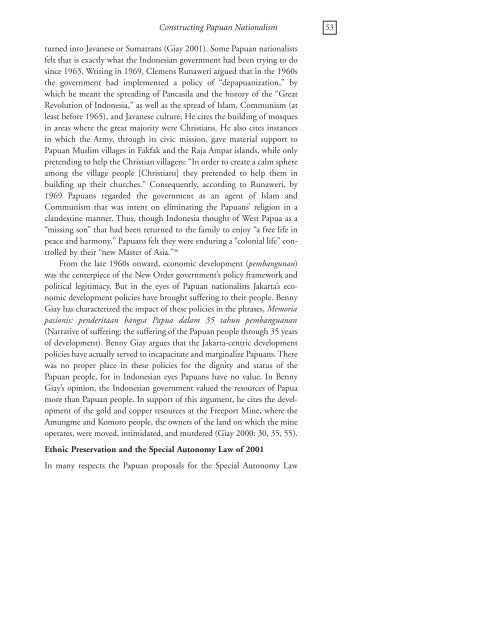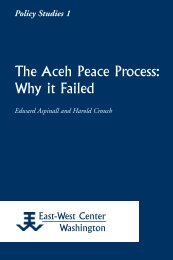Constructing Papuan Nationalism: History, Ethnicity ... - ScholarSpace
Constructing Papuan Nationalism: History, Ethnicity ... - ScholarSpace
Constructing Papuan Nationalism: History, Ethnicity ... - ScholarSpace
- No tags were found...
You also want an ePaper? Increase the reach of your titles
YUMPU automatically turns print PDFs into web optimized ePapers that Google loves.
<strong>Constructing</strong> <strong>Papuan</strong> <strong>Nationalism</strong> 53turned into Javanese or Sumatrans (Giay 2001). Some <strong>Papuan</strong> nationalistsfelt that is exactly what the Indonesian government had been trying to dosince 1963. Writing in 1969, Clemens Runaweri argued that in the 1960sthe government had implemented a policy of “depapuanization,” bywhich he meant the spreading of Pancasila and the history of the “GreatRevolution of Indonesia,” as well as the spread of Islam, Communism (atleast before 1965), and Javanese culture. He cites the building of mosquesin areas where the great majority were Christians. He also cites instancesin which the Army, through its civic mission, gave material support to<strong>Papuan</strong> Muslim villages in Fakfak and the Raja Ampat islands, while onlypretending to help the Christian villagers: “In order to create a calm sphereamong the village people [Christians] they pretended to help them inbuilding up their churches.” Consequently, according to Runaweri, by1969 <strong>Papuan</strong>s regarded the government as an agent of Islam andCommunism that was intent on eliminating the <strong>Papuan</strong>s’ religion in aclandestine manner. Thus, though Indonesia thought of West Papua as a“missing son” that had been returned to the family to enjoy “a free life inpeace and harmony,” <strong>Papuan</strong>s felt they were enduring a “colonial life” controlledby their “new Master of Asia.” 90From the late 1960s onward, economic development (pembangunan)was the centerpiece of the New Order government’s policy framework andpolitical legitimacy. But in the eyes of <strong>Papuan</strong> nationalists Jakarta’s economicdevelopment policies have brought suffering to their people. BennyGiay has characterized the impact of these policies in the phrases, Memoriapasionis: penderitaan bangsa Papua dalam 35 tahun pembanguanan(Narrative of suffering: the suffering of the <strong>Papuan</strong> people through 35 yearsof development). Benny Giay argues that the Jakarta-centric developmentpolicies have actually served to incapacitate and marginalize <strong>Papuan</strong>s. Therewas no proper place in these policies for the dignity and status of the<strong>Papuan</strong> people, for in Indonesian eyes <strong>Papuan</strong>s have no value. In BennyGiay’s opinion, the Indonesian government valued the resources of Papuamore than <strong>Papuan</strong> people. In support of this argument, he cites the developmentof the gold and copper resources at the Freeport Mine, where theAmungme and Komoro people, the owners of the land on which the mineoperates, were moved, intimidated, and murdered (Giay 2000: 30, 35, 55).Ethnic Preservation and the Special Autonomy Law of 2001In many respects the <strong>Papuan</strong> proposals for the Special Autonomy Law
















